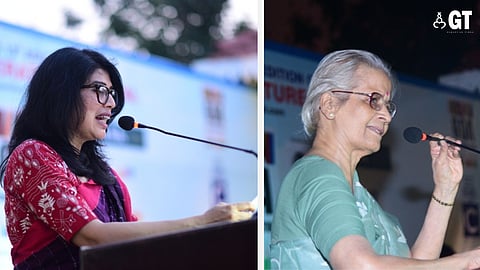

Every year, much magic unfolds under the starlit sky at the inaugural evenings of the Goa Arts and Literature Festival (GALF) on the lawns of the International Centre Goa (ICG) in Dona Paula.
This year too, on Thursday, academic, poet and author Sumana Roy’s compassionate keynote address on the language of trees brought the trees to life, prompting everyone to take notice of them, if only for a moment.
Sahitya Akademi awardee, writer and journalist Shanta Gokhale started on a shaky note, but silence tiptoed when she began speaking on the power of silence, which she lamented was getting drowned in today’s "post-industrial” world.
Unveiling of artist Sonia Rodrigues Sabharwal’s art – which had the goddess of art and literature surrounded by elements of earth, water, fire and air and Goa’s Aboli flower – lit the stage with vibrant colours.
It was accompanied by a beautiful rendition of the mystic poet Kabir’s verse, injecting meditative calmness into the audience.
Body-builder-turned-poet Ramesh Ghadi’s Konkani poem – Mhaka Kaich Farakh Padcho Na (For me, it will not matter at all) – was hard-hitting, delivered gently, yet effectively.
All of this culminated in an invigorating discussion between the Scottish author William Dalrymple and Padmabhushan awardee Vidya Dehejia on the former’s book – The Golden Road: How Ancient India Transformed the World.
The stimulating talk threw up many new facts and busted myths, constructing a premise for showcasing India’s economic, cultural and religious prowess in the “
classical period”.
The Scottish writer, with a flair for Indian history, debunked the much-flaunted ancient Eurasian trade route – Silk Road – which “omits” India on its map.
“It’s my contention that as far as the classical period is concerned, this map (Silk Road) is more or less a lie,” he asserted.
The author of White Moghuls, published in 2002, further added that his research revealed that during this period China and Rome were unaware of each other’s existence; “no direct trade missionary had gone from China to Rome and vice versa”.
In contrast, coastal India – Kerala (known as Muzuris then), Tamil Nadu, Goa and Gujarat – had thriving economic ties with Roman Egypt through the port of Alexandria.
This is evidenced in the hoard of Roman coins found across India’s coastal region, countries along the Mediterranean and Nile but not in China or other countries along the Silk Road.
“And if Rome and China did meet (in that period), it’s probably in the bazaar of Gujarat,” he quipped.
The Muzuris Papyrus, a second-century invoice of merchant shipment discovered several decades back uncovers a lot about the trade patterns during that period. One of the things that stands out is the volume and value of Indian trade.
“Your coastal ancestors were ripping off my Western ancestors for a tiny quantity of pepper it turns out,” he joked.
Giving details, he said a single shipment contained huge volumes of valuable merchandise such as pepper, ivory, cotton and other such items.
“So valuable were the contents of one shipment that if it did successfully reach the Alexandria port, it would have made enough profit, as (can be made out) from this invoice (Muzuris Papyrus), to buy an estate in Roman Egypt or, indeed, in Tuscany and still have enough spare change to join the Roman senate,” he speculated.
He said Rome’s imports, on which customs duties were levied, could have funded a quarter of the Roman imperial budget for roads, forts and its military apparatus.
Dalrymple quoted the Roman author Pliny the Elder, who called India “a sink of world’s precious metal”.
As he excitedly enumerated India’s feats across the spectrum of ancient Indian history, under the inky night sky to a rapt audience, the Scottish author disturbed some of the historical writings on the sands of time.